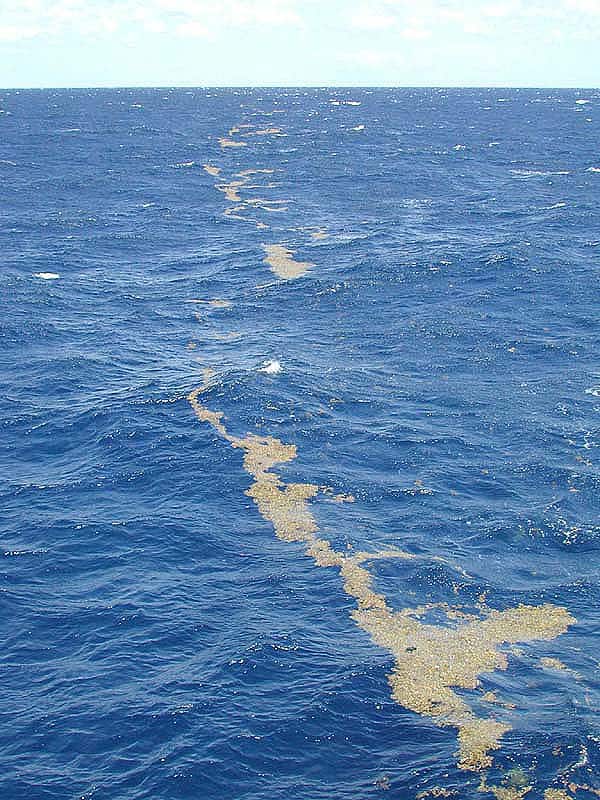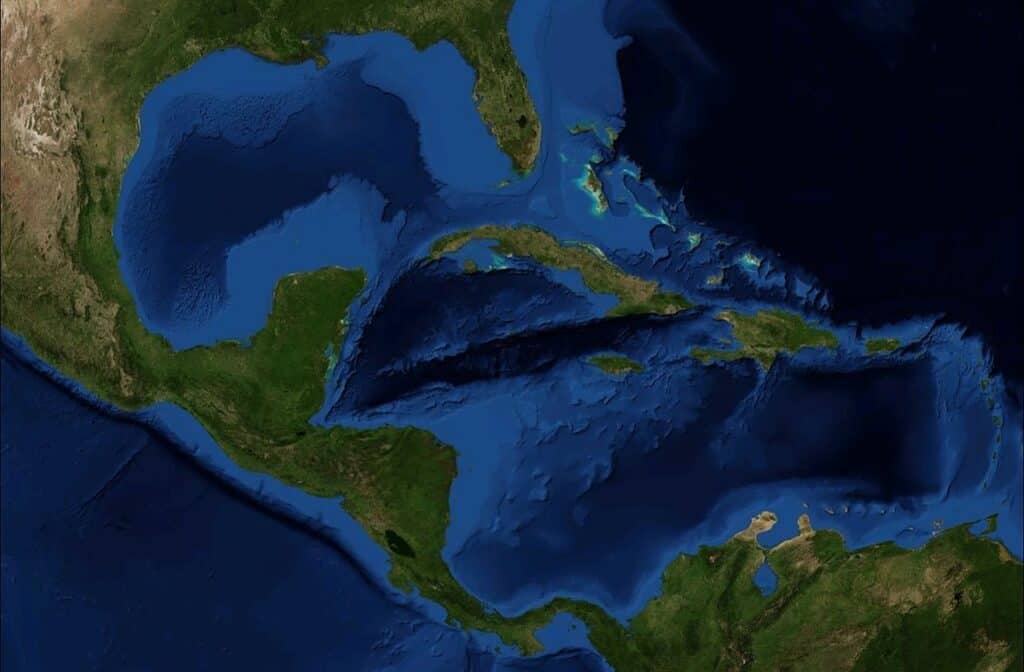Whether you see water on a regular basis or not, the Earth is full of it. In fact, about 71% of the surface of the Earth is covered with water. The oceans hold about 96.5% of the water on this planet, but where is the rest of it?
There is also water in glaciers and ice caps, as well as in aquifers. Water is present as moisture in the ground that you walk on every day and as water vapor in the air that you breathe. Water also exists in lakes, rivers, and seas.
Seas actually hold quite a bit of water themselves. But which are the largest seas on Earth? Read on to learn more about the largest seas in the world!

What Is a Sea?
It can be easy to use the words “ocean” and “sea” interchangeably. However, if you want to be geographically accurate, there is actually a difference between these two terms.
Seas are smaller than oceans. Typically, they are located at points where the ocean meets the land. They are also partially enclosed by the land.
When we talk about the largest sea, there are so many parameters that can be used to define this. However, we are going to go by surface area. The calculation can get a bit complicated if we go by volume, as depth can be difficult to figure out and may not be consistent throughout the sea floor.
5. Sargasso Sea

The Sargasso Sea is the fifth largest sea in the world and has an area of 1,351,358 square miles.
The Sargasso Sea is the fifth largest sea in the world, with an area of 1,351,358 square miles, or 3,500,000 square kilometers. It is quite exceptional in that it is the only sea on the planet that doesn’t have a land boundary. It’s located entirely within the Atlantic Ocean and defined by ocean currents rather than land boundaries.
The western boundary is the Gulf Stream, the northern boundary is the North Atlantic Current, the eastern boundary is the Canary Current, and the southern boundary is the North Atlantic Equatorial Current.
The sea was named after a genus of free-floating seaweed, Sargassum, that freely floats around the water and reproduces vegetatively on the surface of the sea. Other seaweeds do so on the floor of the ocean.
This seaweed has made a great home for many marine species. These include turtles who use mats of this seaweed as nurseries for their hatchlings. There are also many fish, crabs, and shrimp that have adapted to this seaweed. Many eels spawn here as well. Humpback whales, tuna, and multiple bird species migrate through this area and use it for food.
4. Arabian Sea

The Arabian Sea is the fourth largest sea in the world and has an area of 1,491,127 square miles
©iStock.com/Kandarp Gupta
The Arabian Sea, the fourth largest sea in the world, has an area of 1,491,127 square miles, or 3,862,000 square kilometers. It is located in the northern part of the Indian Ocean, bordered by India, Pakistan, Iran, Oman, Yemen, and Somalia.
This sea is also home to many animals, including the humpback whale, killer whale, sperm whale, finless porpoise, common dolphin, and spinner dolphin. In addition to these large sea mammals, there are many species of fish, turtles, and shrimp in the water. There are also birds who fly overhead.
The environment is currently considered to be under siege because of human activities that are causing damage to the ecosystem and putting the animals in danger.
3. American Mediterranean Sea

The American Mediterranean Sea is the third largest sea in the world.
The third largest sea in the world, the American Mediterranean Sea, is 1,621,629 square miles, or 4,200,000 square kilometers. This is actually the somewhat informal name for the dilution basin that includes the Gulf of Mexico and the Caribbean Sea. Cuba, Jamaica, Puerto Rico, and Hispaniola are all islands that separate this sea from the Atlantic Ocean.
This basin is full of biodiversity. It is home to the Caribbean lobster, Atlantic deep-sea lobster, Caribbean roughshark, Bahamas sawshark, and multiple species of marine turtle. There are also many fish, such as the barracuda, sturgeon, spotted butterfly, parrotfish, and many more. Someone exploring these waters would also be likely to find eels, jellyfish, and stingrays.
2. Coral Sea

The Coral Sea is the second largest sea in the world and has an area of 1,849,815 square miles.
©kelldallfall/Shutterstock.com
The Coral Sea is the second largest sea in the world, with an area of 1,849,815 square miles, or 4,791,000 square kilometers. Located off of the northeast coast of Australia in the South Pacific Ocean, it borders this coast of Australia for about 1,200 miles. Queensland lies to the West of this sea, Vanuatu and New Caledonia to the east, and eastern New Guinea to the northeast.
There are many reefs and islands within the Coral Sea. In fact, the Great Barrier Reef, which is the largest reef system in the world, is contained within this sea. The Great Barrier Reef can actually be seen from space and has been designated as one of the seven natural wonders of the world.
The basin of the Coral Sea is thought to have formed about 58 million years ago, as a result of the rise of the Queensland continental shelf. The sea is actually still forming due to seismic activity.
The islands of the Great Barrier Reef are home to over 2,000 species of plants. The Coral Sea also has a very diverse ecosystem, being home to various lobsters, sponges, crayfish, prawns, crabs, and anemones. Additionally, there are at least 30 species of whales (including the humpback whale and dwarf minke whale), porpoises, and dolphins.
There are a minimum of 200 species of birds who visit the shores of this sea. These include the white-bellied sea eagle and roseate tern. There are also 17 species of sea snakes, 6 species of sea turtles, and over 1,500 species of fish.
1. Philippine Sea

The Philippine Sea is the largest sea in the world and has an area of 2,198,852 square miles.
©mrmichaelangelo/Shutterstock.com
The Philippine Sea is the largest sea in the world. It has an area of 2,198,852 square miles, or 5,695,000 square kilometers. It is part of the Pacific Ocean, bordered by the Ryukyu Islands, Taiwan, several Japanese and Philippine islands, and other small islands.
The floor of this sea is the Philippine sea plate, which is constantly moving. An increase in tectonic movements has given rise to the creation of island arcs, which are basically groups of active volcanoes under the sea. These volcanoes can be as much as 1,500 miles tall.
Also, a result of tectonic movements is deep trenches. In fact, the deepest trenches in the world are found under the Philippine Sea. This includes the very deepest location on Earth, which is the Mariana Trench.
Scientists estimate the Philippine Sea to have formed between 119 and 131 million years ago. It’s famous for its amazing biodiversity. The most diverse marine ecosystem in the world can be found here. There are over 500 species of coral and approximately 20% of the known species of shellfish.
In addition to hundreds of species of seaweed and algae, the Philippine Sea is home to many Japanese eels, tuna, whales, giant octopuses, sharks, and multiple turtle species. There are also many rare fish species here, including the blue-spotted angelfish, dugong, whale sharks, and megamouth sharks.
Summary of the 5 Largest Seas in the World
| World Ranking | Sea | Size | Location |
|---|---|---|---|
| 5 | The Sargasso Sea | 1,351,358 sq miles/ 3,500,000 sq km | The Atlantic Ocean |
| 4 | The Arabian Sea | 1,491,127 sq miles/ 3,862,000 sq km | The northern part of the Indian Ocean |
| 3 | The American Mediterranean Sea | 1,621,629 sq miles/4,200,000 sq km | The Atlantic Ocean |
| 2 | The Coral Sea | 1,849,815 sq miles/ 4,791,000 sq km | The South Pacific Ocean |
| 1 | The Philippine Sea | 2,198,852 sq miles/5,695,000 sq km | The Pacific Ocean |
The photo featured at the top of this post is © NaturePicsFilms/Shutterstock.com
Thank you for reading! Have some feedback for us? Contact the AZ Animals editorial team.







